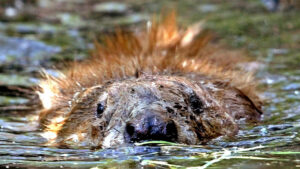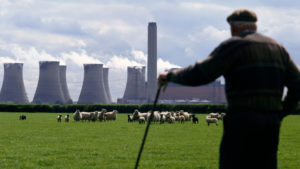The wolf is at the door. My local newspaper Sud-Ouest has informed me that I and the rest of the inhabitants of Charente Maritime “must prepare for the return of wolves”. I howled, in anguish. There are already wolves to the south, in the Lot département. And they do what wolves do: eat sheep. A single female wolf near Caniac-du-Causse has killed 120 ewes in just one year. “One can’t live with this,” berger Pascal Angelibert told Sud-Ouest. “It’s the wolf or us.”
He spoke for the nation’s 60,000 sheep-keepers. We live in fear. France is currently losing 15,000 livestock per annum to the 140 or so wolf packs that run within these borders. The European grey wolf is a canny apex predator that preys on the easiest, largest lump of protein it can kill for the least expenditure of energy: hello sheep. But also on the menu are goats, cattle, and horses. Earlier this month, wolves killed a red deer — not in the wild, but in someone’s back garden.
Humans are also now threatened by the wolf. In February, Joseph Uto, a town councillor in Alpes-de-Haute-Provence, was checking the local water supply when he was surrounded by five wolves — one of which charged him. Uto, a former soldier, managed to hit the aggressor away. After 30 minutes the pack withdrew. The incident is the first incidence of aggression towards humans since the wolf came back to France in 1992. The wolves seem to be losing their atavistic fear of humans.
The attacks on livestock, and the close encounters with humans, will logically only multiply. The national wolf-pack, which now numbers around 1,000 specimens, is enlarging by between 13% and 20% each year. In its way, the lupine advance across France is magnificent. Hunted to extinction in the Thirties, the wolf returned 30 years ago, when a small number of Canis lupus lupus crossed over the Alps from Italy. Since then, wolves have been seen in over half of metropolitan France’s 96 départements. Wolves spread naturally: annually, the previous year’s cubs depart the main pack to seek territories elsewhere. They have been spotted on the outskirts of Paris, in the environs of Dieppe. They have swum rivers, nipped across autoroutes.
Wolves also spread unnaturally. Their progress across France is state-aided. In 2018, Macron’s centrist government published a 100-page “Wolf Action Plan”, announcing its intention to increase the number of the predators on the mainland to 500 by 2023. The move was intended to increase biodiversity — or at least the modish type of biodiversity propagated by celebrity ecologist, Nicholas Hulot, recruited to Macron’s government to green its credentials. To the surprise of no-one in French agriculture, the target figure was easily doubled by the national wolf pack in that time span.
After all, the wolf in France has rigorous protection. Like the rest of the EU signatories to the 1979 Berne Convention and the 1992 EU Habitats Directive, France gives the wolf protected species status, meaning that it can only be controlled by “lethal means” in exceptional circumstances. Effectively, a flock has to be under direct attack for a farmer to shoot a wolf justifiably. To assuage farmers, the state agreed a 10% annual cull — undertaken by the “Wolf Brigade” from the Office for Hunting and Wildlife — which manifestly failed. Ministers have now raised the threshold to 19%.
This is unlikely to satisfy France’s shepherds — or, indeed, France’s already dyspeptic tax papers. In the event of a wolf attack, livestock breeders receive compensation for a replacement animal. Paris also grants subsidies for the building of electrified wolf-defences, “reinforced human presence” (assistant shepherds), and the breeding and training of livestock guard dogs — usually Pyrenean Mountain Dogs known locally as “Patou”. By 2020, the French government had already financed 4,258 of livestock guard dogs, and was sloshing out €38 million in anti-wolf measures and compensation. According to INRAE, the National Research Institute for Agriculture, Food and the Environment, the cost of protecting sheep from wolves is “exploding”.
The money is not well-spent. In the French alpine region, an area where wolves have been present for a quarter century, more than 90% of successful attacks take place on farms that have already adopted the recommended means of protection. In a sober, even downright pessimistic report, INRAE concluded that wolves are “probably taking advantage of their legal status as a strictly protected species”. They have learned to circumvent methods of herd protection.
The boom in Patou is also causing trouble: they only look cuddly. Shepherds may need a dozen dogs to protect their flocks, and 105 people reported being bitten by a Pyrenean mountain dog in 2022. Timothée Dufour, a lawyer who counts shepherds among his clients, said there had been a “multiplication of conflicts” linked to dogs, and a notable increase in lawsuits against sheep-farmers.
Meanwhile, the compensation for dead sheep is inadequate, and only covers mortalities. There are indirect impacts of predation: stressed survivors lose weight, miscarry, reduce their milk supply, and sometimes refuse to graze on the places where they experienced a wolf attack for three years. One breeder, who was reimbursed €1,850 by the state, has estimated her losses at €24,000.
The wolf’s most fervent supporters are the rewilders, who see it as a key player in plans for large-scale restoration of the wildwood that covered France in the primordial mist. Theoretically, the wolf will keep down boar and deer numbers. But the world has moved on from the hunter-gatherer Stone Age; sheep farming in France has created grassland landscapes of globally important biodiversity. The Causse in the Aveyron, for instance, is a Unesco heritage site precisely because of the 2,000-year-old relationship between pastoral farming and the environment.
Nor is the return of the wolf simply a problem for France. In Germany the wolf-pack is growing by 38% annually. In the Netherlands, to deter wolves from approaching humans, authorities are experimenting with paintball guns. In Sweden, licences to kill wolves are being issued to local hunters in blatant disregard for the EU’s wolf-protection legislation. Faced with farmer protests, the European Parliament last Autumn voted to downgrade the wolf’s protected status to facilitate more culling. The Commission, however, appears disinclined to take notice. (Although one assumes that Ursula Von der Leyen, the Commission President might at least lend a sympathetic ear: Dolly, her pet pony, was killed by a wolf in September.)
Either way, the culling of wolves may be counterproductive: according to a 2014 study in the US, if culling is restricted to part of the pack, the remainder break up into several breeding pairs, leading to a higher population and more attacks on livestock in the future. But if selective shooting does not work, and if fences and dogs do not work, then the return of the wolf is now a problem without a solution, short of the animal’s absolute eradication in livestock areas — or the eradication of livestock and their farmers. It’s them or us.
After reading Sud-Ouest’s wolf warning of wolves moving into Charente Maritime, I went to look at my sheep — themselves grazers of biodiverse grassland, rich in fauna such as stone curlew and flora such as pyramid orchids. My shepherd neighbour Jean-Claude passed me on the track, and I asked him his view on the coming of the wolf. He pointed up the hill towards the forest: “We’ll need walls of electric fences everywhere to protect us. It will be like living in a prisoner of war camp.” He has a point. It is starting to feel like a war. And it’s the traditional shepherds, rural communities, and nature itself being taken prisoner.
Disclaimer
Some of the posts we share are controversial and we do not necessarily agree with them in the whole extend. Sometimes we agree with the content or part of it but we do not agree with the narration or language. Nevertheless we find them somehow interesting, valuable and/or informative or we share them, because we strongly believe in freedom of speech, free press and journalism. We strongly encourage you to have a critical approach to all the content, do your own research and analysis to build your own opinion.
We would be glad to have your feedback.
Source: UnHerd Read the original article here: https://unherd.com/



